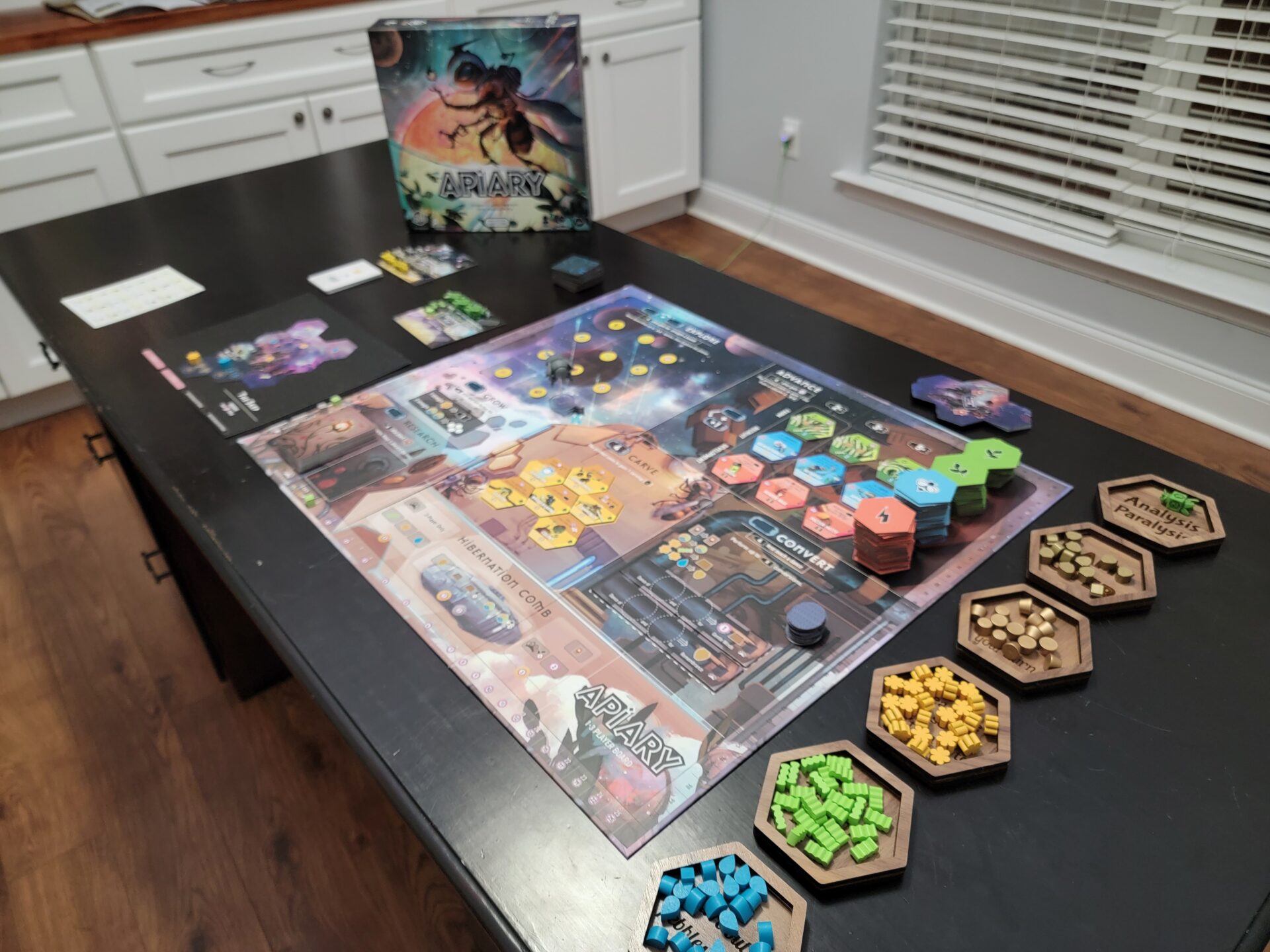
Name: Apiary
Year of Release: 2023
Player Count: 1 – 5
Playing Time: 60 – 90 Minutes
Designer: Connie Voglemann
Publisher: Stonemaier Games
Primary Mechanisms: Worker Placement, Income, Tile Placement
Weight (According to BGG.com): 2.90
Overview
Recently, I was listening to a kid’s podcast with my son and the host invited his 8-year-old guest to answer a simple question: what are two things that make no sense when combined together? My favorite combination was a “weightlifting baby” which spawned a really funny image in my head. If you’ve ever seen the cover art for Apiary then you know where I’m headed with this. If not, then let me give you a quick rundown of the cover art.
Plastered right in the middle of the box is a giant bee. You might think this is going to be another animal themed game, but your eyes quickly start picking up details around the bee. Is that a helmet on its head? If so, why does that helmet look so much like an astronaut’s helmet? Oh, look, it’s also wearing a jetpack and… yep… that’s a giant sun-like orb floating in the background. This bee is not a normal bee, but a space bee and players are going to take command of one of the many (20!) space bee factions and attempt to build up their faction through exploring planets, gathering resources, and develop technologies. You know, just like a… normal bee?
Anyways, if you want to get caught up in the hoopla about the theme of this game and how it’s made a bunch of salty board gaming people on the internet mad, feel free to go research that. All I’m saying is that the idea of being a space bee is wonderfully creative, and the artwork from Kwanchai Moriya is stellar. It doesn’t matter to me one bit that this could have been about space dogs, space pandas or even regular old humans. What matters is whether or not it’s fun. So, is it fun? Read on to find out!
Rulebook & Components

When opening Apiary for the first time, players will notice that it comes packed with a whopping four rulebooks but don’t misconstrue this fact to mean that the game is complex. If you’ve ever played a Stonemaier Games publication that includes a solo-mode created by the Automa Factory, you’ll know that one of these rulebooks is solely dedicated to this mode. You obviously receive the normal rulebook, so what exactly are these other two?
One is the Appendix which, while I haven’t had to grab for it often, is very useful when needed. In a game like Apiary, where variable player powers exist on top of 129 tiles, all with different effects, sometimes players need to be able to thumb through a document to understand exactly how to play or score a certain tile. I’d much rather have all of this printed in a separate book than stuff it into the normal rulebook.
The last document is a Teaching Guide and while I probably shouldn’t really classify this as a “rulebook” (since it’s only a single, double-sided, piece of cardstock), I’m going to because this is my review, and I can do what I want. Honestly, I haven’t used the guide yet but looking over it now that I’ve played multiple times, the execution looks really great and I think it will be very helpful to get new players to the table and started without slogging through a thirty-minute explanation that nobody is listening to. As with many products coming out of Stonemaier Games, the components are top-notch and there are a lot of them. My single favorite component is one of the ones that players will be touching a lot: the Workers. Much like the space bees in the game aren’t just typical bees, these Workers aren’t your typical worker placement meeple. Instead, these workers are built around a cube-design, with four of the faces displaying numbers one through four. The other two sides are molded to give off the look of what a space bee’s spaceship might look like. These Workers are going to be able to be placed on the board with one of the numbers displayed to show its current power and will be turned as the worker grows in power and then eventually hibernates.

I also really like the multitude of tiles that come with the game and the artwork on them, or at least most of them. The green tiles, otherwise known as Farm Tiles, aren’t very exciting to look at but they do their job and easily convey information, such as Income. The next tiles are blue and are for the Recruits. These tiles each depict a new type of bee that will help your Hive prosper, with artwork to match the Recruit’s specialty. There are also Development Tiles that represent space-age technologies that the bees have invented with their massive space bee brains. Lastly, there are the yellow Carving Tiles. The game sets these up as being a priority in the game as there is a limited amount per game, they cost quite a few resources, and they are a main source of Victory Points at the end of the game. Unfortunately, the tiles themselves don’t really give off an air of importance. Honestly, most of them seem like they should be part of the Development Tile stack. I’m not sure what the thematic difference is here, but I wish that the Carving Tiles looked as important as the gameplay suggests.
There are plenty more components to discover in Apiary: a deck of Seed Cards, numerous tokens, a stack of Planet Tiles, and even a QueenShip Miniature. This last component is kind of funny in that it is a fully molded miniature spaceship, that is moved around a 4×4 grid every now and then. Not entirely needed, but a fun addition, especially if you paint miniatures and want to give it a nice coat of Gunmetal Grey.
Setup

By glancing at the board of Apiary, you probably have already realized that setup is going to consist of putting out a lot of tokens and tiles across the board. As far as time length is concerned, Apiary is comparable to similar games in that it takes maybe ten minutes to get it all on the table and ready to play. Instead of discussing how to handle the setup, I’d rather touch on all the areas that offer variability from one play to another, which is going to help Apiary feel fresh over multiple plays.
The first two variables that players will encounter is when they are given their Hive Mat and their Faction Tile. There are only five Hive Mats but each differs from the others in the configuration of building spaces as well as the bonuses players will take advantage of as they build on their mat. The Faction Tiles offer a bit more variability as they determine a player’s starting resources as well as how many Workers (and their power level) they will start with. Lastly, the faction is going to give the player an end-game bonus if they fulfil the requirements. These two things alone can help to change the strategy a player might need to use from one play to another.
The second aspect of the game that changes from play to play has to do with the Dance Tiles. I will get into this more within the gameplay section, but the Dance Tiles are basically a way that players can create additional trade-in recipes for their resources. For example, in one game it might be easy to gather Honey Tokens because of a certain Dance Tile. In the next game, that Dance Tile might not be available, and players need to pivot to collecting more Pollen Tokens to trade for Honey. I like that each player can control one Dance Tile each game and chooses what the recipe is going to be, adding even more variety to the Convert action.
Lastly, when setting up the Carving Tiles, only a select amount is chosen: six for a one-to-three player game, and nine in a four-to-five player game. These are drawn from a pool of 30 Carving Tiles and are never replenished during the game, so once they run out, they’re gone for good. While Apiary’s setup isn’t as variable as some games on the market, I appreciate the places it is and how it strives to be a game that feels different play-after-play.
Gameplay

So, you might be asking yourself, “do we really need another worker placement game, even if has to do with space bees?” For me, the answer would be a resounding, “yes!” only because I just really like worker placement games. But even if you’re not me, and you probably aren’t since that would be really strange, Apiary offers a really nice twist on the regular worker placement formula, fitting somewhere in your collection. Let’s look at this twist in a little more depth.
The first thing has to do with the four numbered values I mentioned up in the component section. Each Worker (typically) starts at a level one, though some start at a level two. This numbers affect how powerful the action the Worker takes is. For example, a Worker with a power of two, can take the Research action, and are allowed to draw two Seed Cards, and choose one to keep whereas a Worker with a power of three, would draw three Seed Cards, and choose one from that. On top of this, most actions give a bonus in addition to the normal action when a level four Worker is placed there. So, how do players upgrade their Workers?
This is done through taking a Retrieve turn, or by having the Worker Bumped back to your Docking Mat. First, let’s discuss Bumping in Apiary. Some of the action spots have spaces for multiple Workers, but most have space for only one Worker. In a lot of worker placement games, once an action spot is populated, no other meeple can be placed there. In Apiary, a new Worker can be placed there, but effectively Bumps the previous worker back to their players mat. In doing so, the Bumped worker powers up and is turned to show the next number on the Worker. Retrieve is similar but is when a player decides to forfeit placing a Worker, and instead pulls back at least one Worker to their mat, powering this Worker up as well.
But, here comes another twist. Obviously, after only a few turns, all your Workers would hit level four and then everyone would be getting the level four benefits. Apiary handles this by forcing Hibernation onto the Workers. If a level four Worker is ever Bumped (or Retrieved) from an action space, they immediately Hibernate. This Hibernation causes a few things to happen. First, that Worker is put back into the Worker Pool, and is not available to the player until they take an action or play a card to Grow a Worker. Second, the player takes a Hibernation Token and places it on a space within the Hibernation Comb. This will allow the player to receive a small bonus and a chance at some end game Victory Points if they happen to have a majority of tokens within any of the Hibernation Comb Pods. Filling up the Hibernation Comb (or a player using up all of their Hibernation Tokens) also acts as the trigger for the last round.
This workflow is really creative to me for a few reasons. One, you need to be selective on where you place your Workers, because if you’re constantly Bumping your opponent Workers, you’re helping to power them up faster. Second, once you get a Worker to level four, you need to be efficient on where you deploy it, as it is going to Hibernate within the next turn and be out of play. If you’re not careful, you could end up with only a single Worker at level one and be stymied for quite a few rounds in a row. Lastly, you can’t play it too slow because it’s a race to get into the Hibernation Comb for those extra Victory Points and to control when the game is going to end.
There are six actions that players can take, some definitely more interesting than others. The Explore and Advance actions are probably my favorite. Explore allows you to move the QueenShip mini, discovering new planets that will help you gather more resources. The Advance action is where you can go to place more tiles into your Hive, giving you discounts or other bonuses throughout the game. On the flip side, the Grow action is pretty boring in that it only really allows you one option, which is to gain a new Worker. Yes, you can also add a Frame to your Hive, which is basically four additional plots to build on but it’s not like you’ll be adding Frames all game long. I will also bring up the Carve action again. It happens to be the only action where you must place a level four worker, spending Honey Tokens to place one of the limited Carving Tiles into your Hive. Again, this all points to this action being a powerful action that the players are working their stingers off to take, but when you actually do take the action, it’s all a little anticlimactic. It just seems too similar to the Advance action, and I wished it stood out in a more meaningful way.
Solo Mode Thoughts
Up front, I’m a big fan of the Automa Factory modes that come packaged in most Stonemaier Games productions. I’ve had a lot of fun with Apiary’s version but it definitely doesn’t replicate playing another human player. I say this because, as with many Automa modes, the AI is controlled by a deck of cards, but Apiary’s cards don’t have any sort of intelligence check to understand where a Worker would best be played. The AI just sticks a Worker wherever the card tells it to, uncaring of where the player might have Workers deployed. The only difference is that most cards do instruct the AI to take a Carve action if they have any level four workers, overriding the other action printed on the card.
All-in-all, this is a small gripe with the solo mode. I can’t even imagine the time and brainpower it takes to create an Automa mode that even works, much less fun. I commend Apiary’s Automa mode for what it does, as it has obviously been fun enough for me to play it numerous times, but I don’t think it stands as one of the premier solo variants in modern board gaming.
Conclusion

Apiary has been a wonderful surprise, as I really didn’t know what I was getting when I purchased it. I’m really glad that it wasn’t just another worker placement game and instead does enough to separate itself from the hive. Yes, some people will complain about the theme (and the price tag) but in my opinion, it’s a high-quality product that will appeal to fans of worker placement games or those that enjoy a lot of variety in their gaming sessions.
Rating
Ratings are based on 5 main criteria: rulebook, setup, components, art & graphic design, and gameplay. The first 4 criteria are rated 1 to 5 and the gameplay is rated 1 to 10. These scores culminate in an “overall satisfaction” score that is rated from 1 to 10. If the reviewed game has both a solo and multiplayer mode, I have assigned scores separately to give context to which mode we enjoy more.
Links
As an Amazon Associate I earn from qualifying purchases.

